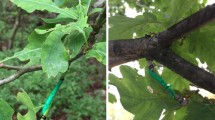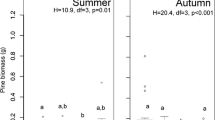Summary
Checker-throated antwrens (Formicariidae: Myrmotherula fulviventris) live in lowland neotropical forests and forage from dead curled leaves in the understory. Because they search each leaf individually they provide an opportunity to study the use of potential visual cues by an insectivorous bird. Long and highly curled leaves contain the most arthropods and checker-throated antwrens were more successful when foraging at those leaves. Yet, they used leaves at random with respect to these potential cues. Antwrens spent longer searching for arthropods in each highly curled leaf than in less curled leaves. Because of this additional search time, prey capture success per unit foraging time was only slightly greater for highly curled leaves than at the average dead leaf in the aerial leaf litter. Thus, the cues that antwrens could use to locate richer leaves are those features that obscure the prey from avian predators. Unlike other foraging systems, the antwrens appear to have no reliable cues indicating more profitable foraging sites.
Similar content being viewed by others
References
Alcock J (1973) Cues used in searching for food by Red-winged Blackbirds (Agelaius phoeniceus). Behaviour 46:174–188
Gass LC, Montgomerie RD (1981) Hummingbird foraging behavior: ecological, ethological and psychological approaches. Garland Press, New York London, pp 159–198
Gill, F, Wolf L (1975) Foraging strategies and energetics of East African Sun birds at mistletoe flowers. Am Nat 109:491–510
Gradwohl J, Greenberg R (1980) The formation of antwren flocks on Barro Colorado Island, Panama. Auk 97:385–396
Gradwohl J, Greenberg R (1983) The breeding season of antwrens on Barro Colorado Island, Panama. In: Leigh EG, Rand AS, Windsor D (eds) The ecology of a tropical forest: seasonal rhythms and long-term changes. Smithsonian Inst Press, Washington, DC, pp 345–351
Greenberg R, Gradwohl J (1980) Leaf surface specialization in birds and arthropods in a tropical forest. Oecologia (Berl) 915:879–887
Heinrich B (1975) The energetics of pollination. Annu Rev Ecol Syst 6:139–170
Heinrich B (1979) Foraging strategies of caterpillars: leaf damage and possible predator avoidance strategies. Oecologia (Berl) 42:325–339
Heinrich B (1981) Bumblebee economics. Harvard University Press, Cambridge, Mass, 245 p
Heinrich B, Collins S (1983) Caterpillar leaf damage and the game of hide-and-seek in birds. Ecology 64:592–602
Hill WF, Spear NE (1963) Choice between magnitudes of reward in a T-maze. J Comp Physiol Psychol 56:723–726
Houston AI, Krebs JR, Ericksen ST (1979) Optimal prey choice and discrimination time in Great Tit (Parus major L.). Behav Ecol Sociobiol 6:169–175
Jones CE, Buchman SL (1974) Ultra-violet floral patterns as functional orientation cues in Hymenopterous pollination systems. Anim Behav 22:481–485
Krebs JR, Kacelnick A, Taylor P (1978) Test of optimal sampling by the great tit (Parus major). Nature 275:27–31
Ridgely R (1976) A guide to the birds of Panama. Princeton University Press, Princeton New Jersey
Robinson S, Holmes R (1982) Foraging behavior of forest birds: the relationship among search tactics, diet, and habitat structure. Ecology 63:1918–1931
Simons S, Alcock J (1971) Learning and foraging persistance in White-crowned Sparrows Zonotrichia leucophrys. Ibis 113:447–483
Smith JNM, Dawkins R (1971) The hunting behavior of individual great tits in relation to spatial variation in food density. Anim Behav 19:695–706
Smith JNM, Sweatman HPA (1974) Food searching behavior of tits in patchy environments. Ecology 55:1216–1232
Sutherland NS, MacIntosh NJ (1971) Mechanisms in animal discrimination learning. Academic Press, New York
Thien LB, Marks BG (1972) The floral biology of Arethusa bulbosa, Calopogon tuberosa, Pogonia ophioglossiodes (Orchidaceae). Can J Bot 50:2319–2325
Thorpe RW, Briggs DC, Estes JR, Erickson EH (1975) Nectar florescense under ultra-violet radiation. Science 198:476–478
Wiley RH (1971) Cooperative roles in mixed species flocks of antwrens (Formicariidae). Auk 88:881–892
Willis EO (1972) The behavior of Spotted Antbirds. Ornithol Monogr 10:1–162
Zach R, Falls JB (1976) Foraging behavior, learning and exploration by captive ovenbirds (Aves: Parulidae). Can J Zool 54:1880–1893
Zach R, Smith JNM (1981) Optimal foraging in wild birds? In: Kamil AC, Sargent T (eds). Foraging behavior: ecological, ethological and psychological approaches. Garland Press, New York London, pp 95–109
Zug GR, Zug PB (1979) The marine toad Bufo marinus: a natural history resume of native populations. Smithson Contrib Zool 284:1–58
Author information
Authors and Affiliations
Additional information
Address for correspondence
Rights and permissions
About this article
Cite this article
Gradwohl, J.A., Greenberg, R. Search behavior of the checker-throated antwren foraging in aerial leaf litter. Behav Ecol Sociobiol 15, 281–285 (1984). https://doi.org/10.1007/BF00292990
Received:
Accepted:
Issue Date:
DOI: https://doi.org/10.1007/BF00292990




